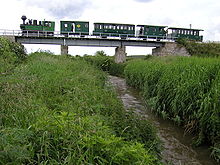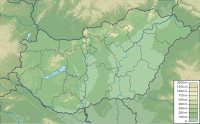 | ||
| Nagycenk | ||
| County | Győr-Moson-Sopron | |
|---|---|---|
| Residents | 2.003 (2015) | |
| height | unknown | |
| no value for height on Wikidata: | ||
| no tourist info on Wikidata: | ||
| location | ||
| ||
Nagycenk (German: (Groß-) Zinkendorf) is a village in the vicinity of Sopron in northwest Hungary. The place is best known for the late baroque castle of the Széchenyi family and the museum railway.
background
The village was already settled in the Hallstatt, Roman and Avar times. The place itself was first mentioned in 1291. The noble family Széchenyi maintained their mansion here. The best-known offspring of this family was Graf István Széchenyi (1791-1860). The entrepreneur and liberal politician went down in history as a great state reformer and modernizer of Hungary. A museum in the castle and the Széchenyi Museum Railway are dedicated to him.
Districts:
- Nagycenk - the main town
- Kiscenk - the smaller neighboring town
- Csitkés - one Gated community for wealthy residents
getting there
By plane
- Airport Wien-Schwechat. 85 km away.
By train
- Nagycenk station on the ROeEE / GySEV railway line from Sopron to Szombathely (Trains approximately every hour; the journey from Sopron takes 10 minutes, from Szombathely 40 minutes; from Vienna you can get to Nagycenk with one change in Sopron in 1½ – 2 hours, from Wiener Neustadt the fastest connection via Sopron takes 50 minutes)
- Fertőboz train station (approx. 3 km outside of town) on the ROeEE / GySEV railway line from Sopron to Gyor (Trains every two hours; the journey from Györ takes about 1½ hours)
By bus
In the street
Main road 85 branches off in Nagycenk (Sopron - Gyor) from Hauptstrasse 84 (Klingenbach - Sopron - Balaton) from. From Sopron (12 km) you drive about 10 minutes, from Eisenstadt (33 km) half an hour, from Szombathely or Wiener Neustadt (55 km each) three quarters of an hour, from Győr (80 km) or Vienna (85 km) a good one Hour.
By bicycle
- Iron Curtain Europe Cycle Route (Iron Curtain Trail)
- Several local and regional bike path connections ins Deutschkreutzerland, to Sopron and Lake Neusiedl
mobility
- Széchenyi Museum Railway from Fertőboz Station to Széchenyi Castle - see also sights.
Tourist Attractions


- Széchenyi Castle. With István Széchenyi Memorial Museum: part of the Unesco world heritage site Lake Neusiedl. Manor house converted into a castle from 1741 in late baroque and classicist style. The main gate (1741-1750) by Franz Anton Pilgram. István Széchenyi had the facility modernized from 1834 to 1840 (master builder Ferdinand Hild). Badly damaged towards the end of the Second World War, the original interior design hardly preserved. Reconstruction 1969–1973 partly as a museum, the rest became a castle hotel and restaurant (currently closed).
- Széchenyi Museum Railway. Connection of the Fertőboz train station with the Széchenyi Castle. Track width 760 mm, route length 3.6 km, five stops, one quadruple coupled and two triple coupled steam locomotives, eight passenger cars and two baggage cars. It was opened in 1972 and is now operated by the ROeEE / GySEV. Children and young people do voluntary work in the company in their free time. At the end of the route (Kastély station) there is a small open-air museum with old railway vehicles.
- Church of Szent István király. Neo-Romansch, 1864, Miklós Ybl.
- Szechenyi mausoleum
activities
shop
Kitchen and accommodation
- The castle hotel and restaurant in the Széchenyi Castle has been closed since 2014, a new opening is uncertain.
- Csikós Csárda Restaurant, at the junction of highways 84 and 85.
- There is a larger selection of accommodations, among others. in Sopron
Practical advice
trips
- Deutschkreutz, 7 km to the west, neighboring Austrian town
- Sopron, 12 km northwest, with a beautiful old town
- Fertőd, 16 km to the east, with a large baroque palace - the "Hungarian Versailles"
- Bük, a good 30 km south, health resort with thermal spring
- Kőszeg, 38 km southwest, historic old town and castle

